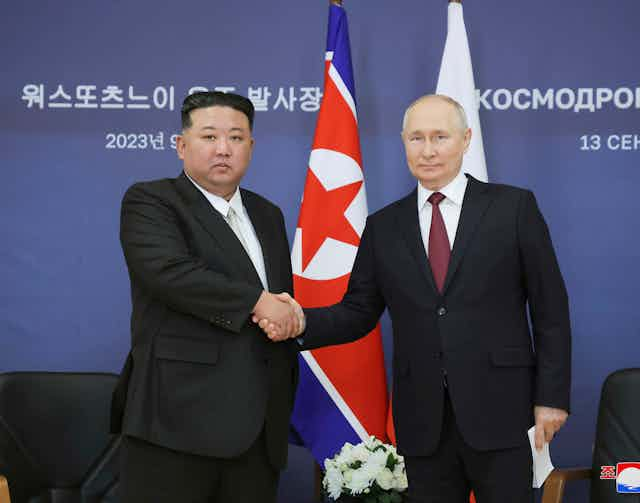North Korean leader Kim Jong-un has reportedly offered his “full and unconditional support” to Russian President Vladimir Putin during his visit to eastern Russia this week.
Analysts speculate this could mean ammunition for Russia’s war in Ukraine, given North Korea is believed to have large quantities of ammunition compatible with Russian artillery. It may be of limited help to Russia, though, given North Korean ammunition has low reliability and accuracy and the fact Russia still needs to transfer it thousands of miles to the front.
But what does Kim want? As always, North Korea is in need of food, fertiliser and potentially other humanitarian aid. However, it seems unlikely Kim would travel all the way to Russia solely for food aid.

How Russia can help the North militarily
North Korea’s nuclear weapons and missile program is at an inflection point.
Even though outside verification is impossible, North Korea’s nuclear weapons seemingly work. The regime has conducted six nuclear tests between 2006 and 2017. North Korea has also tested increasingly sophisticated ballistic missiles.
But it is unclear how survivable these missiles would be against anti-ballistic missile systems, to what extent the nuclear weapons on top of the missiles have been miniaturised, how accurately the missiles can be aimed and how consistently they can be launched.
North Korea’s two failed spy satellite launches in the past several months suggest that it has problems with reliability.

Russia could, in theory, offer North Korea missile technology know-how from decades of experience in weapons development, as well as advanced satellite technology. This could give North Korea’s spy satellite program a boost after years of trying.
Russia might also be able to offer North Korea submarine technology, giving the regime an alternative means of launching nuclear weapons. North Korea is reportedly already developing submarine-launched ballistic missiles.
Advances in submarine and missile technology could potentially push Japan and South Korea to further strengthen their own deterrents. However, the two are already building up their military capabilities and increasing cooperation with each other and the United States in the face of perceived threats from China and North Korea. So, this trend is likely to remain unchanged.
What Russia certainly cannot provide North Korea is military aid on an industrial scale. This is, in fact, Russia’s greatest weakness: the war with Ukraine is consuming its weapons and ammunition far faster than it can manufacture them.
And its capacity to manufacture newer, high-tech weapons has been inhibited even further by sanctions (though some imports of Western, high-tech equipment and materials are still trickling in via nearby countries).
Read more: As Russia woos nations to support its war in Ukraine, will fault lines deepen around the globe?
An offer of a new economic partner
Russia also offers North Korea a way out of its strategic quandary. After the UN Security Council imposed sanctions on North Korea over its nuclear program in 2009, many countries cut their trade ties with the regime. This left the North uncomfortably dependent on China.
As a result, North Korea has opportunistically sought to redevelop ties with other countries to reduce its susceptibility to Chinese pressure. The spate of summits with South Korea, the US and Russia in 2018 and 2019 was part of this strategy, but it yielded little in concrete benefits for North Korea.

Kim’s latest summit with Putin in eastern Russia is a continuation of this policy, but conditions have changed. Now, Kim may have a way to effectively render the UN sanctions regime dead.
The main barrier to China, and more importantly, Chinese firms, giving technology and other sanctioned items to North Korea is fear of US secondary sanctions and being cut off from US dollar transactions. This has limited Chinese aid to North Korea, even if it has not stopped it entirely.
Because Russia is now under Western sanctions itself, it no longer cares about either of these consequences for giving aid to North Korea.
Russia is limited only by the extent to which it does not want to engage in nuclear weapons and missile proliferation, and its wariness of creating a sophisticated nuclear-armed country on its own borders.
At his meeting this week with Kim, Putin said all options for cooperation were on the table, including perhaps helping North Korea with its satellite program. Needless to say, this would be in direct violation of UN sanctions, as well as Russia’s own commitments to the Missile Technology Control Regime.
Perhaps just as important, if Russia no longer cares about UN sanctions, this gives North Korea another, perhaps more consistent means of bypassing sanctions on all goods, not just military technology.
In recent years, North Korea’s imports and exports have been limited to ship-to-ship transfers at sea and land routes that go through China. And Beijing has cracked down on trade with the North when it has wanted to in the past.
Pursuing Russia as a new economic partner opens up the rail route between Vladivostok and North Korea, as well as shipping routes between North Korea and eastern Russia, which have already played a role in the past in North Korea’s coal smuggling operations.
Read more: Camp David summit turns attention to North Korea, as well as China

